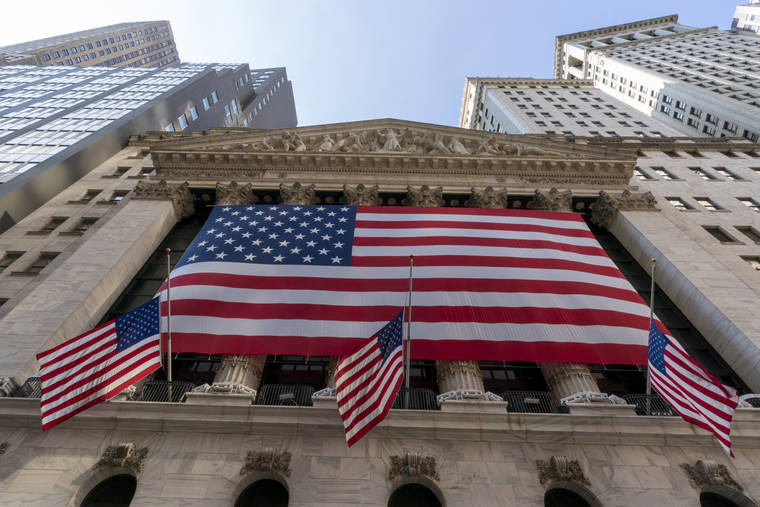Stocks notched broad gains on Wall Street Monday as investors looked ahead to Election Day and the potential for a turbulent stretch for markets.
The S&P 500 climbed 1.2%, recouping some of its losses from a sharp sell-off last week, as more companies reported stronger profits for the summer than Wall Street feared and reports on manufacturing came in better than expected. Health care, industrial and financial companies drove much of the broad rally, which followed gains for European and Asian stocks following their own better-than-expected economic data.
Caution, though, was continuing to hang over markets as the pandemic raises worries that customers will stay away from businesses and pushes more European governments to bring back restrictions. Uncertainty about Tuesday’s U.S. elections is also weighing on markets, and Treasury yields were mixed.
“People are probably more than willing to hold off to see what happens tomorrow night,” said David Trainer, CEO of investment research firm New Constructs.
The S&P 500 rose 40.28 to 3,310.24. The Dow Jones Industrial Average gained 423.45 points, or 1.6%, to 26,925.05. The Nasdaq composite picked up 46.02 points, or 0.4%, to 10,957.61. The index had been down 0.7%.
Small company stocks fared better than the broader market. The Russell 2000 small-caps index rose 30.11 points, or 2%, to 1,568.59.
It’s an incredibly busy week for markets, with the Federal Reserve announcing its latest decision on interest rates Thursday, the U.S. Labor Department releasing its market-moving monthly jobs report on Friday and roughly 130 companies in the S&P 500 scheduled to report their results for the summer through the week.
Blaring above them all is Election Day. Markets have veered sharply in recent weeks as investors deal with uncertainty about who will control Washington, and what that means for the chances of the U.S. government delivering more aid for the economy.
Many professional investors say they plan to hold steady through whatever volatility the election creates. That’s because history shows politics don’t have a very strong correlation with market returns over the longer term. But Wall Street is nevertheless girding for potentially big swings in the interim.
The feared scenario for investors is a contested election, where it could take weeks for a winner of the White House to emerge. Markets famously hate uncertainty, and many along Wall Street expect stocks to drop in such a scenario.
Which party gets control of the Senate may be just as important as the presidency. If Democrats can gain complete control of Washington, many investors expect them to deliver a big dose of support for the economy. That plus “more predictable trade policy” could offset the higher tax rates and tighter regulations likely to come out of a Democratic-controlled Washington, says the BlackRock Investment Institute.
The Russell 2000′s solid gains Monday may signal that traders are betting Joe Biden will be elected president and that he’ll push for a big-ticket economic stimulus package, which would help smaller companies, said Quincy Krosby, chief market strategist at Prudential Financial.
“The biggest question for the market, if Biden does win, is does he bring the Senate with him?” she said. “Because for many of his proposals he’s going to need cooperation from the Senate.”
Democrats and Republicans have been haggling about a stimulus renewal for months, since the last round of supplemental benefits for laid-off workers and other stimulus expired. But a deep partisan divide has so far stymied them.
The U.S. economy has been showing a mixed performance recently. A Monday report on manufacturing from the Institute for Supply Management gave a reading of 59.3, where anything above 50 indicates growth. That topped economists’ expectations for 56. But Friday’s upcoming jobs report may show a fourth straight month of weakening job growth, according to economists’ projections.
Investors and economists alike say the economy needs another shot of stimulus, particularly when coronavirus counts are accelerating at troubling rates across Europe and much of the United States. So far, the toughest restrictions on daily life and businesses have not returned. But even if they don’t, the worry is that fear about the virus will keep customers away from businesses by itself.
Such worries helped drive the S&P 500 to a 5.6% loss last week. That was its worst since March, when worries about the first wave of the pandemic were sending stocks around the world into a free fall.
Corporate profits, meanwhile, are weaker than year-ago levels but continue to be better than Wall Street had feared.
Nielsen Holdings rose 3.8% and Clorox gained 4.2% after each of the companies reported better results than analysts expected. Companies in the S&P 500 are now on track to a decline of slightly less than 10% for the summer from a year earlier. That’s not as bad as the nearly 21% drop analysts were expecting at the start of October, according to FactSet.
European markets closed broadly higher after a survey showed industrial output in the region was strong in October. Asian markets also rose after a major indicator for China’s manufacturing sector rose.
The yield on the 10-year Treasury fell to 0.85% from 0.88% late Friday.
———
AP Business Writer Yuri Kageyama contributed.


